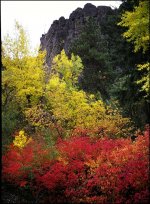pdx138 said:
Thanks again for all the comments. Now its time to find out for myself how I like the 645 format. I bought a Fuji GS645S today!
...
Any helpful pointers on getting the most from this camera?
Kyle, congratulations on the purchase of a sweet little camera! That model was my first medium-format RF and I'm still fond of it. It's particularly light and compact, an easy rig to have with you always. And the lens is excellent. I also like the vertical carry...
But these tend to be a bit delicate, the "cattle guard" around the lens serves as a hint of impact vulnerability. Be gentle with it. Mine had three unseen faults when I got it. First, the RF mirror was sticky; it would move fine with the focusing one direction but sometimes would stick when moving back the other way. Just needed cleaning and lube, as it turned out.
Secondly, the light meter was non-linear in response to light. It was accurate in daylight but got progressively off in lower light. Calibration fixed it.
Thirdly, physical damage to the lens mount. All plastic in there, and evidently the camera had taken a whack on its nose and broke some internal plastic. A visible hint of this was on the squarish bezel trim piece around the lens... the one rounded corner nearest the viewfinder was separated slightly from the body surface. It needed a new plastic internal part.
I took it to a professional repair shop in Seattle, where it was pronounced "infeasible to repair", sadly. Later on, I heard of Camera Wiz, a Fuji repair specialist, and after brief communication sent the camera to him. In short order it was fully repaired, adjusted, lubed, cleaned, etc for modest cost. I was delighted to have it working like new.
Even before it was repaired, the problems didn't stop me from taking it as my only camera overseas on vacation. I had a hand-held meter for dimmer light, while the camera's own meter reading balanced against "sunny 16" common sense did the trick in daylight. The broken lens mount didn't really cause any trouble, and when the focus patch got sticky, patting the camera might snap it free, or for that matter zone/guess/scale focusing worked fine much of the time too. One copes! And even then I liked the camera well enough to do so.
Hope you like yours as much! Just be gentle. One film-loading trick common for 120/220 film cameras: After you get the paper leader attached to the takeup reel, rest your thump on the roll in the feed side as you wind on to the starting arrow. The idea here is to make sure the leader is wrapped tightly on the takeup reel at the start. This helps ensure the film all fits tightly at the end, without any distressing light leakage at the sides. Most cameras have some built-in resistance on the feed-reel side, but a bit more drag right at the beginning doesn't hurt.


